Rafute (ラフテー) is a traditional braised pork belly recipe from Okinawa, Japan. This juicy and tender dish is slow-cooked in awamori (Okinawan distilled liquor), Okinawan black sugar, and soy sauce. It‘s a savory and sweet classic that simply melts in your mouth.
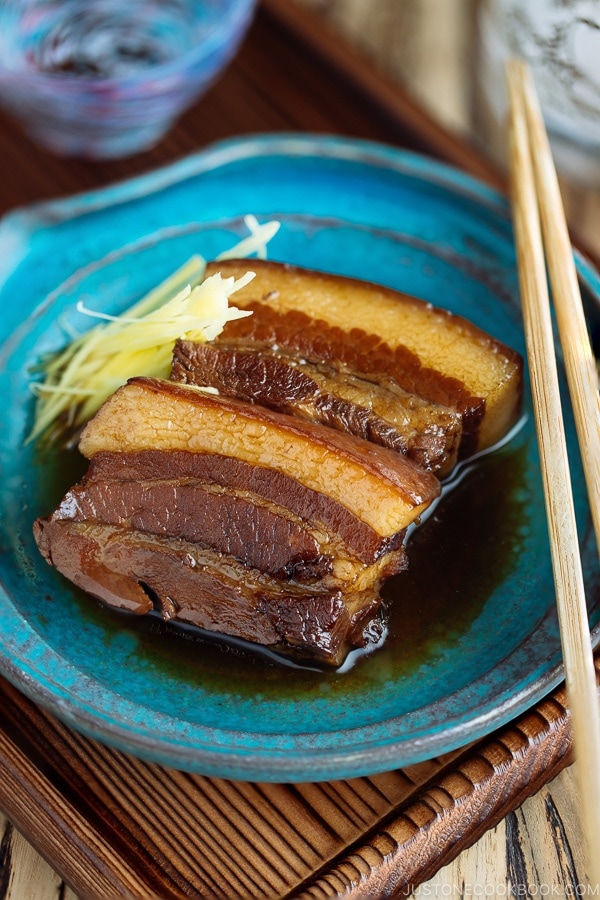
When you are in Okinawa, you have to try this braised pork dish called Rafute (ラフテー). We tried Rafute in different restaurants during our 5-day trip in Okinawa, and noticed that each place made their own variation. Despite its “fatty” look, this braised pork belly dish is surprisingly light as all the fat is rendered from long hours of cooking. It is so tender, it falls apart when trying to eat it with chopsticks. Rafute really is a must-try dish to experience on a trip to Okinawa!
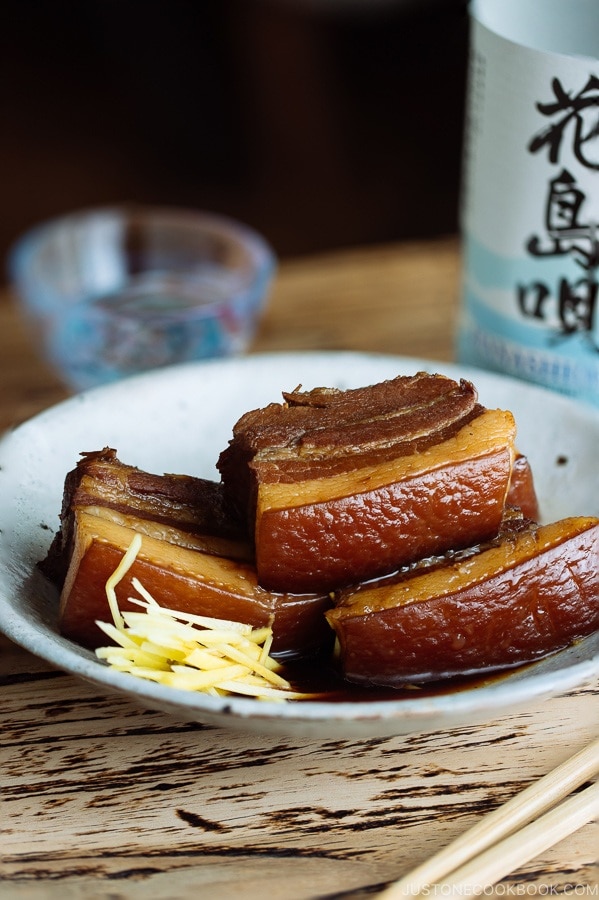
What’s Rafute?
Rafute is a pork belly dish slowly simmered in sweet and savory sauce, with an origin from a famous Chinese dish called Dong Po Rou (东坡肉/東坡肉), Chinese braised pork belly. Rafute has been eaten in Okinawa since the Ryukyu Kingdom (1429–1879) when it was served as a form of Okinawan Royal Cuisine.
Rafute consists of the three most signature produce/products in Okinawa: pork, black sugar, and awamori (distilled liquor).
The slow cooking process yields the most tender and melt-in-your-mouth texture. While simmering, the fat renders and the pork belly soaks up all the delicious flavors. The skin and fat of the pork belly become gelatinous and even chopsticks can break down the meat easily. You don’t have to worry about the meat being greasy at all.
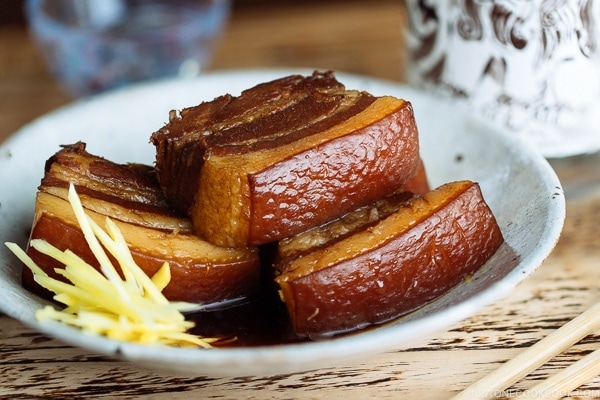
Differences Between Rafute and Kakuni
If you’re familiar with the classic Japanese braised pork belly called Kakuni, you may wonder what makes Rafute different from Kakuni.
Well, these two dishes are pretty similar in appearance, as both are influenced by Chinese braised pork belly. While studying how to make Rafute, I noticed a few things that are different in the cooking process from a typical Kakuni recipe.
1. Use pork belly with skin on top
Typically, Japanese grocery stores sell pork belly without skin, so I had to go to an Asian grocery store to make this specific pork belly with skin. Each piece is much bigger, so I asked them to cut it into 2 lbs. You want to pick a leaner piece that comes with some meat but not too fatty. Ideally, it should have even layers of fat and meat.
2. Pre-boiling with just water
Just like Kakuni recipe, pork belly needs to be cooked on low simmer for 1-2 hours. During this time, Kakuni is almost always cooked with ginger and green onion. However, for Rafute, the majority of recipes use only water. You could add ginger and green onions, but I found it not necessary. The use of awamori was good enough to cook off the pungent meat flavor.
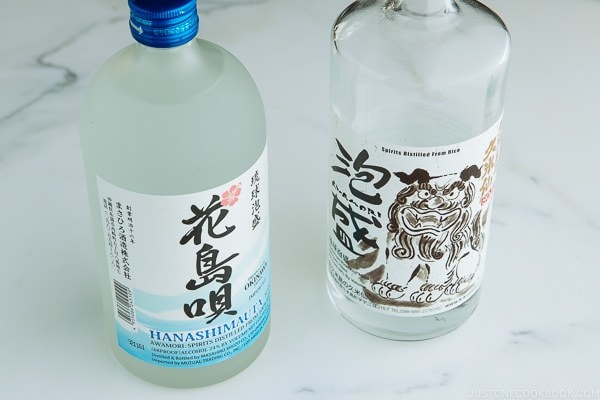
3. Use Awamori instead of Sake
If you have no access to awamori, the Okinawan distilled liquor (shochu), you can use sake instead. But I highly recommend using awamori for an authentic version. I think awamori and black sugar makes Rafute different from Kakuni, giving a complex sweetness to the pork.
4. Use “Black Sugar”
Traditional Rafute is made with Okinawa black sugar Kokuto (黒糖). As I couldn’t find Okinawa black sugar in Japanese grocery stores here or on Amazon, I researched other alternatives for “black sugar” online and found out Muscovado sugar is a good choice (read more about this sugar here). Muscovado sugar is a type of partially refined to unrefined sugar with a strong molasses content and flavor.
I tried making Rafute with both granulated sugar (white sugar) and dark brown sugar to see the difference. Mr. JOC and I found that Rafute made with black sugar tastes far better than granulated sugar – more umami and complex flavors, and slightly better than dark brown sugar.
Since I used Muscovado sugar to make other Okinawan recipes including Sata Andagi (Okinawan Donuts) and Okinawa Soba, I encourage you to try finding this cane sugar to make these three Okinawan recipes.

Substitute Tips to Make Rafute
Skin-on Pork Belly: You can use skin-on or skin-off pork belly depending on availability. You can use other cuts of the meat, but I believe it won’t come out as good as pork belly.
Awamori: If your local Japanese grocery stores do not carry it, then use sake or vodka. I still recommend using awamori.
Black Sugar: Unless you’re in Okinawa or Japan, it’s hard to get Okinawan black sugar. Muscavado sugar is the best substitute for this dish. Major grocery stores such as Trader Joe’s, Walmart, Whole Foods or your local co-ops should carry Muscovado sugar. You can also buy it online on Amazon or other specialty stores. The sugar is also excellent in many other savory dishes like pulled pork, barbecue sauces, and marinades, so it would be a good buy.
Soy Sauce: Use regular Japanese soy sauce. I often get questions if I use dark or light soy sauce. In Japan, we don’t have dark or light soy sauce as Chinese cuisine does. We do have dark-colored soy sauce (koikuchi shoyu, mostly used in the Tokyo area) and light-colored soy sauce (usukuchi shoyu, mostly used in the Osaka area) but the texture is both thin and almost the same. You can read a little bit more about Japanese soy sauce here.
Also, I added soy sauce at 3 different times. The first time with the rest of the seasoning ingredients, the second time after 1 hour of cooking, and the third and last time after 30 minutes. We do this for two reasons. First, we prevent the pork from getting darker in color. Basically, you don’t cook pork with 5 Tbsp of soy sauce for 1.5 hours. Second, sugar is absorbed into the meat well before soy sauce or salt is added. If your flavor gets salty, it’s hard to undo by adding sugar. Therefore, it’s best to add salty condiments later on.
The long-simmering aside, Rafute is a fairly simple dish to make. The robust flavor makes it an iconic dish in Okinawa. You can enjoy it as an izakaya-style dish with some icy cold beer or as a savory dish to go along with fluffy steamed rice or noodles.
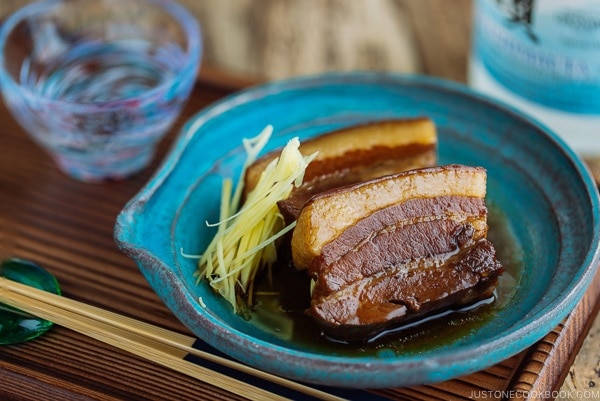
Wish to learn more about Japanese cooking? Sign up for our free newsletter to receive cooking tips & recipe updates! And stay in touch with me on Facebook, Pinterest, YouTube, and Instagram.
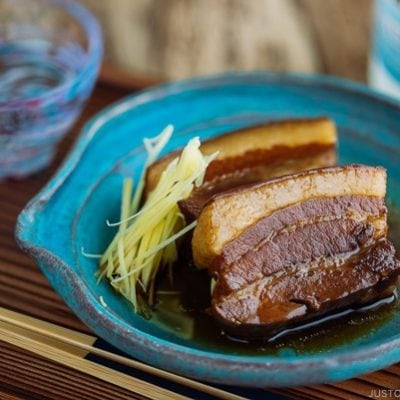
Rafute
Video
Ingredients
- 2 lb pork belly block (boneless, skin on)
- 4 cups water
- 2 cups katsuobushi (dried bonito flakes) (packed)
- 1 cup awamori (Okinawan distilled liquor) (you can substitute it with sake or vodka)
- ½ cup black sugar (packed; you can purchase Okinawan black sugar on Amazon; I used dark muscovado sugar)
- ⅓ cup soy sauce (5 Tbsp, divided)
- 1 knob ginger (1 inch, 2.5 cm)
Instructions
- Gather all the ingredients.

- Place 2 lb pork belly block in a large pot, skin side up. Add just enough water to cover the pork and bring it to a boil.

- Boil for 1 minute and discard the water.

- Rinse off the scum and foam from the pork belly under cold water. Quickly rinse the pot, put the pork belly back in the pot, and fill it with cold water.

- Bring the pot to a boil once again, and skim off the scum and foam. Then, reduce the heat to a gentle simmer and cook uncovered for at least 1–1½ hours. Leave the pot uncovered to release the unwanted odor. If the water has evaporated and the pork belly is not covered with water, add some boiling water. Keep skimming as needed.

- Meanwhile, boil 4 cups water in a small pot. Once boiling, add 2 cups katsuobushi (dried bonito flakes).

- Let it simmer for 15 seconds. Turn off the heat and let the katsuobushi steep in the pot. Set aside. We’ll be using this katsuo dashi shortly.

- Slice 1 knob ginger and cut into julienne strips. Soak them in water for 10–15 minutes to remove some of the spiciness. Drain well and set aside for garnish.

- After 1–1½ hours of cooking the pork belly, transfer the pork to a plate and cover with aluminum foil to keep it from drying out. Set it aside until it‘s cool enough to handle. Tip: You can reserve the pork broth for Okinawa Soba, Champon, or soup (strain and freeze it).

- Once the meat is cool enough to handle, slice the meat 2–3 cm (¾–1⅕ inches) thick. Add the pork belly slices to a heavy-bottomed pot (I used Le Creuset).

- Strain the katsuo dashi into the pot.

- In the pot, add 1 cup awamori (Okinawan distilled liquor), ½ cup black sugar, and 2 Tbsp soy sauce. Please read the blog post about why we don‘t add the entire ⅓ cup soy sauce at once.

- Mix the liquid and make sure the pork belly is covered with the sauce. Bring it to a gentle simmer and skim off any scum and foam. Place an otoshibuta (drop lid) and cook over medium-low heat for 1 hour. Read my post about otoshibuta and learn how to make your own drop lid.

- After 1 hour, add another 2 Tbsp soy sauce, and cook for 30 minutes.

- After 30 minutes, add the remaining 1 Tbsp soy sauce. Cook until the pork is very tender and the skin/fat are glossy and gelatinous, roughly 15 minutes. Serve the pork belly on a plate/bowl and pour some braising liquid on top. Garnish with the ginger slices. Enjoy Rafute with steamed rice and some vegetables. You can also serve on Okinawa Soba.

To Store
- You can keep the leftovers in an airtight container and store in the refrigerator for up to 4 days and in the freezer for a month.
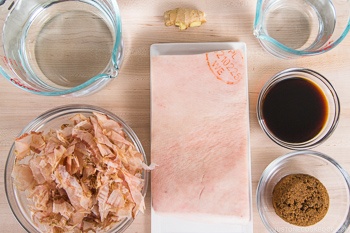
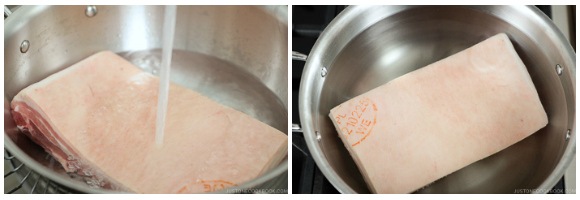
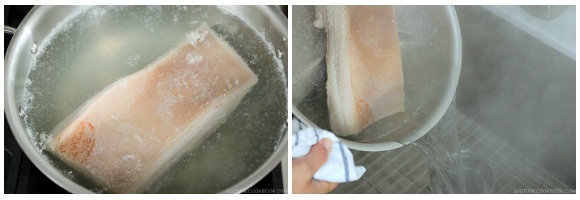
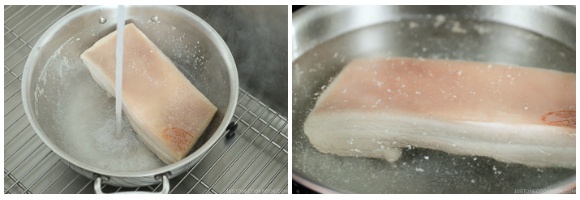

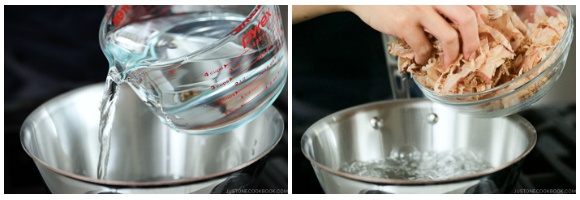
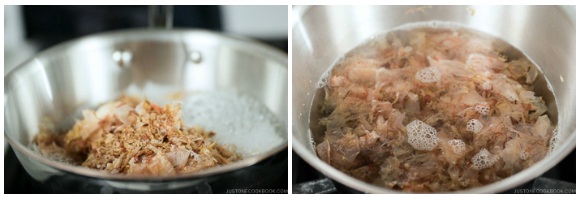


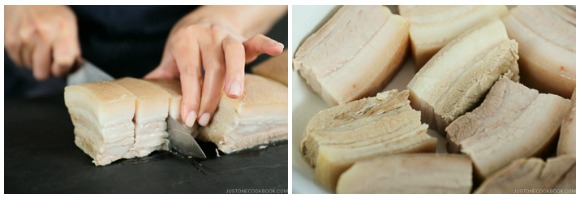
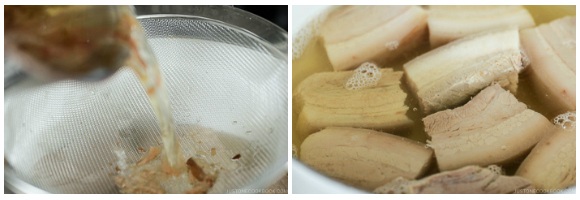


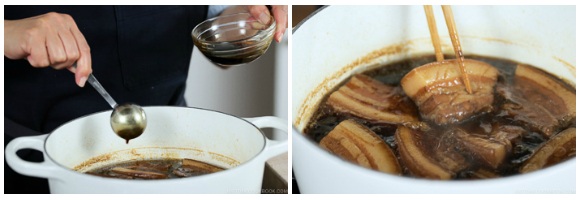











Dear Nami, I found this recipe while searching. It looks delicious. As I don’t eat pork, I wonder if there is a suitable substitute for the pork meat?
Hi Kris! Thank you so much for reading Nami’s post.
Short rib or well-marbled beef would be a good substitute, but feel free to adjust the cooking time.
We hope this helps!
Would Chinese brown sugar 片糖 that comes in flat blocks be a good substitute for the Okinawa black sugar or do you still prefer muscovado brown sugar? Would you happen to know the weight of 1/2C brown sugar? Google says 85g. Thanks so much.
Hi Karen! Thank you for trying Nami’s recipe!
We haven’t tested it using Chinese brown sugar, but it should be okay. Nami used 90 g of dark muscovado sugar in this recipe.
We hope this helps!
My Japanese husband loves it! Thank you for this recipe!
Hi Dominika! Thank you very much for trying Nami’s recipe and for your kind feedback!
We are glad to hear your husband loves Rafute!
I am so happy to have found this recipe you posted. I have some Okinawa black sugar that I bought while there but never even opened. Now I have a delicious use for it!
Hi DelMar! Yes! Okinawa Black Sugar is perfect for this recipe!☺️
Thank you very much for reading Nami’s post and trying her recipe!
Love all your cooking. I hope one day I can purchase your cook book
Hi Cristina!
Thank you very much for your kind feedback!
Currently, Nami has an eBook that you can order here (https://www.justonecookbook.com/just-one-cookbook-essential-japanese-recipes/). If you are looking for a print version, we have it available on Amazon (https://amzn.to/35Ahqge).
Enjoy! 🙂
I would love to try this recipe but all I could get my hands on were pork belly slices, rather than a pork belly block. Can I just cook it for less time? Thank you
Hi Elina! Yes, hopefully, it won’t be breaking down too much (as the fat melts). Slices are great for grilling or simmering with little cooking liquid. 🙂
The pork came out amazing. One of the best tasting pork I’ve ever had. I didn’t have bonito flakes so I substitute with half the broth the pork cooked in and half wonton soup broth I had in the fridge. I also used regular brown sugar and sake instead of ingredients in the recipe. The pork still came out great.
Hi Jade! Yay! I’m really glad to hear you enjoyed the recipe. Thank you for your detailed and kind feedback!:)
I just found the black sugar on Amazon:
Origin Sugar Company – Raw, Unrefined Japanese “Kokuto” Black Sugar from Hateruma Island – Whole Cane Sugar (500 grams)
Is this the correct thing?
Hi Eileen! That sounds good. Hope you enjoy the recipe!
[…] Okinawa World – おきなわワールド (recipe – Rafute) […]
Is it possible to make this dish with thr instant pot?
Hi Christine! From the second half (Step 10), I think Instant Pot will work okay (but you don’t need that much broth due to no evaporation). The only drawback is that you have to put all the soy sauce at once. Now for the first part of cooking, where you boil the pork, it’s best that lid is open so that unwanted smell of pork will go away and not cook with it. I think it helps lender fat better when you cook slowly for a longer period of time. If you don’t mind the small details of the cooking or taste, I think IP will shorten cooking time for sure. I prefer not to use it because it’s fatty meat. 🙂
Nami San, thank you for your reply!